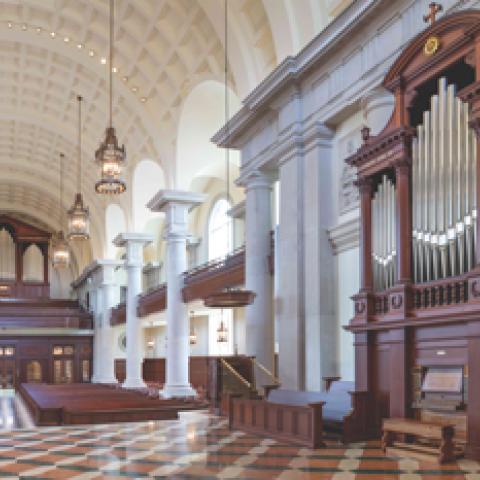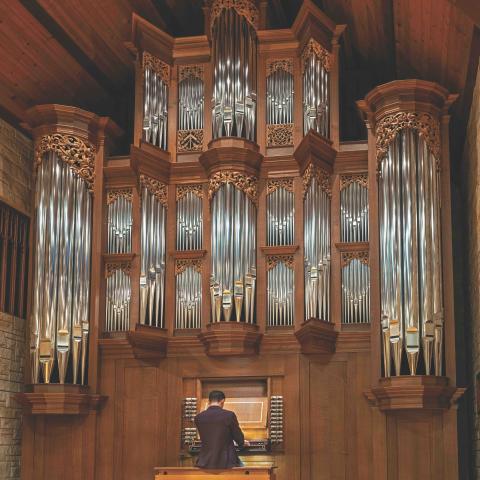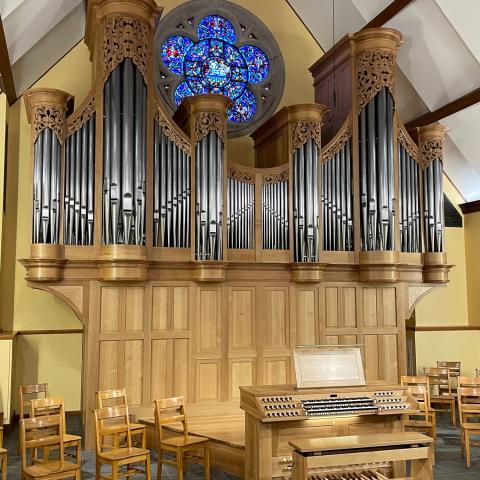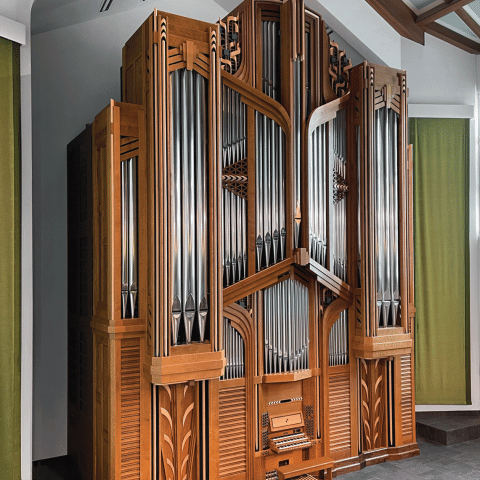Paul Fritts & Company Organ Builders, Tacoma, Washington; Hillsdale College, Hillsdale, Michigan

From the builder
Paul Fritts & Company Organ Builders has recently completed the last of two new significant organs, the firm’s Opus 44 and Opus 45, for Christ Chapel at Hillsdale College in Hillsdale, Michigan. The chapel was completed in 2019 and provides seating for 1,350 within the 27,500-square-foot building. Designed by architect Duncan Stroik, the interior of the classically inspired chapel is modeled after St. Martin-in-the-Fields in London and Christ Church, Philadelphia. The 64-foot-high barrel vault ceiling, stone columns, wooden pews, and polished marble floors provide the space with excellent acoustics, especially in the elevated chancel at the front of the nave. In addition to regular services, the chapel provides space for college ceremonies and concerts. Consultant for the organ projects Dr. Paul Thornock and the builder worked extensively together with the architects throughout all phases of the project to insure the best possible musical and logistical results.
The design phase for these two projects was extensive. Never before were we tasked with building cases designed by the architect of the building where they stand. This requires a unique collaboration due to the tonal and structural requirements of an organ often unfamiliar to architects. The work ended well, problems were solved, and we are proud of the collaboration and how it has expanded our design scope.
Early on when the building was being designed it was determined that rather than making one very large organ, the needs of the program would be better served by two organs. Opus 44, completed concurrently with the new building in 2019, is conceived as a “choir” organ and speaks from the side of the chancel where it is in close proximity to small and large ensembles. Its 30 stops are divided between three divisions: the Great at impost level, the Swell above, and the Pedal divided on either side. The organ case is made of sapele mahogany to match all of the woodwork throughout the chapel. Its musical resources are designed to support a wide variety of service music and organ repertoire. The organ serves admirably as a solo and concert instrument in its own right, and it was dedicated with a concert by Nathan Laube on April 15, 2021.
To provide support for singing for a full congregation and to serve as a concert instrument, the Gallery Organ, Opus 45, has three manuals and pedal. Installation and tonal finishing were recently completed in October 2022. It, too, is housed in a sapele mahogany case with a large “broken” pediment, columns, and architectural capitals. The polished tin façade pipes are the lowest notes of the Great and Pedal Principal 16′ stops, both of which are independent. The en fenêtre keydesks of both organs are in the front center of the cases.
Both organs feature suspended mechanical key actions providing a light but easily controlled touch while sending tactile feedback to the player. Stop actions are mechanical with the inclusion of “intelligent” solenoids and 999-memory-level combination actions. General and divisional pistons, coupler and 32′ reversible toe studs, and a sequencer with multiple “forward” pistons and studs are part of both combination systems.
The stoplists were drawn up by the consultant and the builder. Both organs have substantial principal choruses on each of their divisions along with a variety of flute and string stops and are capped with a generous array of reed stops. The Gallery Organ includes both a large-scale 32′ Subbaß and an independent 32′ Posaune. Both French and German Trompets at 8′ reside in the Great, and a French-style 8′ Cromorne in the Positive as well as a Cavaillé-Coll inspired 8′ Hautbois in the Swell and 8′ Flûte Harmonique in the Great. There is also a Renaissance-style 8′ Trompet with duck-billed shallots included in the Swell. All are voiced with full-length resonators for a full yet colorful sound that blends appropriately with the overall organization of voicing style and related pipe design throughout. Compact design with reasonable access was important for space reasons and focus of the sound.
The Gallery Organ is similar in its layout to the Choir Organ, with the organ’s three manual divisions triple decked in the center with the Positive at the lowest (impost) level, the Great above, and the Swell at the top of the 38-foot-tall case. The Pedal division is divided on either side of the manual divisions. The 32′ Subbaß bass octave is placed on two windchests (C and C-sharp) at floor level at the rear of the case. Directly in front of the large Subbaß pipes, the 32′ Posaune stands on two windchests at floor level, the tallest of the tin resonators reaching to the top of the case.
The large pipes in the center façade are the lowest nine pipes (C to G-sharp) of the Great 16′ Principal. The largest four pipes of the Pedal 16′ Principal (C to D-sharp) are wooden, made of sugar pine, mounted inside the case. The Pedal façade pipes begin at E and continue to tenor f. The four smaller façade pipes in the outer fields and closest to the center field continue the Great 16′ Principal up to tenor e.
The pipes for both organs were made entirely in the Fritts workshop, the metal ones constructed of two alloys—high lead and high tin—that have been cast on sand. The process dates to ancient times and was the method used for the pipe making of Gothic and Renaissance organs and continued in some instances well into the Baroque period. The very rapid cooling of the pipe metal on the sand bed (compared to a relatively long cooling period on a cloth-covered table) produces material with a smaller crystalline structure, which has discernible benefits to the sound of the pipes. The speech of the pipes is enhanced with the pipes reaching their steady-state tone seemingly more quickly with less fuss, and with less obtrusive harshness and speech noise. Windways can be generous and pipe toes open encouraging a free, colorful, and unforced sound on relatively low wind pressures. The overall impact of the organs can then be determined by wind pressure and to a lesser degree pipe scales.
The Gallery Organ has five wedge-shaped bellows, all positioned within the case. The Great and Positive divisions share two bellows that have been carefully balanced to work together for good support of these divisions. The Pedal division makes use of one similarly sized bellows for the C and C-sharp sides and the Swell has its own bellows. The bass octave pipes of the 32′ Subbass are directly winded from the blower’s static pressure windline, which provides them with 120 mm (4¾ inches) of wind pressure. The Great and Positive divisions are winded at 74 mm, the Swell on 70 mm and the Pedal division on 76 mm.
The two organs are pitched identically at 440hz @ 70°F. Both utilize Kellner’s “Bach” temperament.
The Gallery Organ is provided with a dedicated air conditioning system that was planned at the outset and built as a part of the chapel construction. During summertime, air-conditioned air is circulated throughout the organ case and is regulated by a thermostat high in the Swell. During the heating season, air will continue to circulate throughout the case to control temperature stratification. Experience with similar systems in our organs has shown this to be critical for keeping vertically separated divisions in tune with one another.
The success of an organ project, or in this case, two projects, depends upon a great number of contributing factors. Chief among them is installing the organs in advantageous locations in a great space. A well-developed design and tonal plan along with meticulous craftsmanship and expert voicing and tonal finishing lead to outstanding results. The melding of the countless and seemingly disparate elements into a cohesive whole that is greater than the sum of its parts is the special alchemy that is superb organ building.
Special thanks go to the administration of Hillsdale College for their foresight and vision in commissioning these instruments and to project advisor, Dr. Paul Thornock. Thanks and appreciation also go to the staff of Paul Fritts & Company: Greg Bahnsen, Zane Boothby, Rain Daley, Paul Fritts, Raphi Giangiulio, Erik McLeod, Andreas Schonger, Bruce Shull, Ben Wooley, and to our bookkeepers and business managers, Robyn Ellis and Marlon Ventura. Carving work was provided by Dimitrios Klitsas.
The completion of the Gallery Organ will be celebrated with an inaugural concert by Nathan Laube on April 13, 2023.
—Paul Fritts
From the consultant
The Hillsdale organ project began with a phone call from the architect who expressed the desire for a new organ to be as special and specialized as the building itself. The desire for mechanical action was in place before the consultant was hired.
An organ in the new Christ Chapel would be required to do many things, including playing for academic ceremonies, accompanying the college’s choirs and orchestras, playing repertoire, and serving as a teaching instrument. Hillsdale College President, Dr. Larry P. Arnn, believes that, “To elevate the hearts and minds of the faithful, Christ Chapel must be a home for musical beauty of the highest order.” Further, his desire to create a regularly sung evensong in the chapel was given considerable weight. The college’s large symphony orchestra also had to fit in the chancel.
The available space in the chancel precluded building a single large instrument in the front of the building that would completely fulfill the musical mission. Further, there was no appetite for placing an organ on the main axis at the front of the building. The only solution was two organs of complementary but distinct characters.
This visionary project was truly an “if you build it, they will come” affair. The college wished to build a sacred music program, and the administration understood that the infrastructure had to be in place to do it. Therefore, an organ professor was not yet in place during the design phase. The committee, which consisted of the architect, consultant, and various administrators, traveled throughout the Midwest to see and hear dozens of instruments by six of North America’s distinguished builders. It is fascinating how committees often have an “Aha!” moment in visiting a particular organ; this moment happened when they visited the Fritts organ at the DeBartolo Performing Arts Center at the University of Notre Dame.
The result is a workhorse two-manual organ in the chancel with an efficient but developed Swell division that enables the organist to render choral accompaniments convincingly and to play the many liturgical events in the chapel, including evensong. The instrument also has sufficient power to pair with the orchestra. The Gallery Organ is the heroic instrument the college desired for large convocations and concerts.
Dr. Arnn’s ideals are borne out in these examples of the organ art: “There never has been a great university unconcerned with the question of the Divine. More than one-third of our students are involved in music—an invaluable gift that helps us to contemplate beauty, harmony, and meaning. To that same end, our splendid organs will help point man’s thoughts toward God.”
—Paul Thornock
From the architect
Christ Chapel at Hillsdale College, Michigan, is the first freestanding chapel in the college’s 175-year history. Located on the main axis of campus and forming a new quadrangle, the classical brick and limestone exterior features a domed circular entrance portico with Doric columns. Three concave entry doors lead into an elegant barrel-vaulted nave with limestone columns and mahogany side balconies. Large arched windows fill the space with natural light.
The Choir Organ is located along the side wall of the chancel and framed by a limestone arch and Doric columns engaged to the wall. The case is 24 feet tall by 13 feet wide. Carved mahogany Corinthian columns divide the façade of the organ case into a taller central section and two side wings. This architectural motif (called a “Serliana”) is found throughout the chapel, such as on the second level of the main exterior façade, and the window above the altar in the chancel. A gold leaf inscription in the frieze of the entablature of the organ case reads: Laudate eum in Chordis et Organo (“Praise him with strings and pipes,” Psalm 150). Carved mahogany laurel wreaths punctuate the pedestal of the organ. Limestone relief panels in the chancel show a harp, trumpets, cymbals, and floral swags, visually depicting the praise of God called for in the psalm.
The Gallery Organ case harmonizes with the Choir Organ but is much larger, 30 feet tall by 30 feet wide. Its overall shape is also a Serliana motif. It has four 15-foot-tall fluted composite columns. An elaborate entablature and broken pediment with a receding apex are above. It also has an inscription across the pulvinated frieze: Cantate Domino Canticum, Novum Quoniam Mirabilia Fecit (“Sing to the Lord a new song, for he has done great wonders,” Psalm 98).
While there are some examples of college chapels with two organs in the United States, there are few examples of the organs being conceived together. The architect has designed five other cases in the United States for both new and historic organs, and was inspired by the Saint-Sulpice grand orgue case by the architect Jean-François Chalgrin. The two new organs will be the centerpieces of Hillsdale’s expanding music program.
—Duncan G. Stroik
Builder’s website: www.frittsorgan.com
Architect’s website: www.stroik.com
College website: www.hillsdale.edu
Choir Organ, Opus 44
GREAT (Manual I)
16′ Bourdon
8′ Principal
8′ Salicional
8′ Rohrflöte
4′ Octave
4′ Spitzflöte
2-2⁄3′ Quinte
2′ Octave
Mixture IV
8′ Trompet
4′ Trompet
SWELL (Manual II)
8′ Principal
8′ Gamba
8′ Voix celeste
8′ Gedackt
4′ Octave
4′ Rohrflöte
2-2⁄3′ Nasard
2′ Gemshorn
1-3⁄5′ Tierce
Mixture III–IV
16′ Fagott
8′ Trompet
8′ Basson/Hautbois
PEDAL
16′ Subbass
8′ Principal
8′ Bourdon*
4′ Octave*
16′ Posaune
8′ Trompet
*Some pipes transmitted from other stops
Couplers
Swell to Great, Great to Pedal, Swell to Pedal
Polished tin front pipes
Suspended, direct mechanical key action
Mechanical stop action with electric pre-set system
Tremulant
Compass: Manual 58 notes; Pedal: 30 notes
Gallery Organ, Opus 45
GREAT (Manual I)
16′ Principal
8′ Octave
8′ Salicional
8′ Rohrflöte
8′ Flûte Harmonique
4′ Octave
4′ Spitzflöte
3′ Quinte
2′ Octave
Mixture VI–VIII
Cornet V
16′ Trompet
8′ Trompet
8′ Trompette
SWELL (Manual III)
8′ Principal
8′ Gedackt
8′ Baarpijp
8′ Violdigamba
8′ Voix celeste
4′ Octave
4′ Koppelflöte
2-2⁄3′ Nasat
2′ Octave
2′ Blockflöte
1-3⁄5′ Terz
Mixture V–VI
16′ Trompet
8′ Trompet
8′ Hautbois
8′ Vox Humana
POSITIVE (Manual II)
8′ Principal
8′ Gedackt
8′ Quintadena
4′ Octave
4′ Rohrflöte
2-2⁄3′ Nasat
2′ Octave
2′ Waldflöte
1-1⁄3′ Larigot
Sesquialtera II
Mixture VI–VII
16′ Dulcian
8′ Trompet
8′ Cromorne
PEDAL
32′ Subbaß*
16′ Principal
16′ Subbaß
8′ Octave
8′ Bourdon*
4′ Octave
4′ Nachthorn
Mixture VI–VII
32′ Posaune
16′ Posaune
8′ Trompet
4′ Trompet
2′ Cornet
*Some pipes transmitted from other stops
Couplers
Swell to Great
Positive to Great
Swell to Positive
Great to Pedal
Swell to Pedal
Positive to Pedal
Polished tin front pipes
Suspended, direct mechanical key action
Mechanical stop action with electric pre-set system
Swell Tremulant
Great & Positive Tremulant
Wind Stabilizer
Compass: Manual 58 notes; Pedal: 30 notes
Opus 44 Choir Organ:
30 stops; 38 ranks; 1,854 pipes
Opus 45 Gallery Organ:
57 stops; 85 ranks; 4,115 pipes






